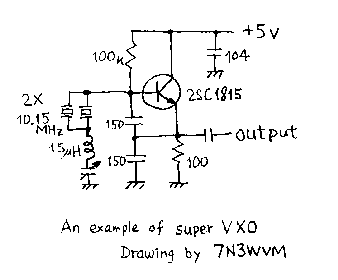
Super VXO
Cryptic letters are codes for Japanese/Chinese
characters. English readers may skip them.

The Super VXO uses two X-tals of the identical nominal
frequency in parallel instead of a single X-tal of a conventional
VXO. Nothing else is special. It can pull considerablly more
frequencies than the conventional one. About 40kHz for a pair of
10.15MHz X-tals, and 90kHz for 13MHz, according to my experiences.
The Super VXO was invented and named by JAfAS(Mr. Shimizu, Silent Key) and
JH1FCZ(Mr. Okubo). An article on experimental results of the
Super VXO first appeared(in Japanese) in the August 1980 issue (Number
64) of "Fancy Crazy Zippy", an HB- and QRP-related
periodical magazine published by JH1FCZ. The story of their
invention of the Super VXO is reported in a book(written in
Japanese) entitled "Textbook for Homebrewing of Electronic
Circuits" (the original title is in Japanese.) written by JH1FCZ.
The followings are my experimental results.
(1)Two 10.15MHz X-tals in parallel + 15uH inductor + 20pF poly-variable
cap. covered the range of 10.10 - 10.14MHz. I built a 30m direct
conversion QRP XCVR with it. Frequency is very stable. The
transistor used is 2SC1815, a common general purpose small signal
TR with fT=80MHz.
(2)Two 13MHz X-tals in parallel + VXO-50 coil(see below) + 30pF
air variable cap. gave the range 12.91 - 13.00MHz. The transistor
used is again 2SC1815.
The VXO-50 coil is designed specially for VXO for 6 meter rigs
and sold by the FCZ-lab, a company owned and run by JH1FCZ(they
sell many kits and special parts for HAMs). This coil is slug-tunable
with a core of small temperature coefficient. The inductance
ranges between 7 and 11uH.
This Super VXO is used in my 6m QRP SSB
super-het XCVR. The VXO freq is multiplied by 3 and used
with IF of 11.2735MHz to cover the freq range of 50.00 - 50.27
MHz (270 kHz !). Frequency is acceptablly stable but not so
stable as the above example of 10.15MHz. A change in voice pitch
is audible in a long QSO.
I have results also on 20m CW XCVR
and 40m CW XCVR. Refer to
descriptions for those rigs.
A X-tal with a frequency below 10MHz is hard to pull by more than
50kHz even with this method if you need stable freq. The lower
the frequency, the narrower the range. Therefore, for lower
bands, you need to choose appropriate IF
to cover the wide freq range with Super VXO of higher freq.
A 3rd over tone X-tal can be used at its fundamental frequency.
The frequency range could be made wider with larger inductance
value, but the frequency stability gets worse rapidly with
increasing inductance. JH1FCZ recommends in his book mentioned
above that one should keep the freq range within 0.5% of the
nominal freq to maintain the freq stability, namely 50kHz for 10MHz
for example.
I tried super VXO's with various types of inductors of the same
value, and found that inductors with larger physical size seem to
work better. Those who want to experiment this method may need to
try with as many types of inductors as possible. Increasing the
bias current of the TR may also help in case it does not
oscillate.
As you vary the frequency, you might observe a sudden skip of the
frequency with hysteresis. This phenomenum can be cured by
putting a 10- to 30- kiloohm resistor in parallel to the inductor.
You might want to use a surplus square canned slug-tunable coil
of an appropriate inductance for Super VXO, but the freq
stability depends on the temperature coefficient of the core
material used. Commonly used core materials seem to have large
temperature coefficients.
I have no experience of Super VXO with an iron powder troidal
core inductance, but proper choice of the core material is also
the key in the sense of the freq stability.
Experiment, experiment, and
experiment!
No reward without experiments.